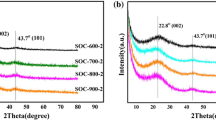Abstract
Meso- and microporous nitrogen-containing carbons, characterized by homogeneous meso- (V = 1.00 cm3/g, D = 3.5 nm) and microporous (V up to 0.26 cm3/g, D ≈ 0.5 nm) structure, and the presence of basic groups (up to 1.7 mmol/g) were obtained by matrix and bulk carbonization of sucrose in the presence of melamine or urea. It is shown that obtained N-containing microporous carbons possess good interfacial capacitance (0.21 F/m2) and they are characterized with stability during repeated charge–discharge cycles. Synthesized N-containing nanoporous carbons show higher adsorption of carbon dioxide (up to 6.3 mmol/g at −20 °C) than the samples without nitrogen (up to 3.9 mmol/g at −20 °C).









Similar content being viewed by others
References
Kim J, Choi M, Ryoo R (2008) Synthesis of mesoporous carbons with controllable N-content and their supercapacitor properties. Bull Korean Chem Soc 29(2):413–416
Hulicova-Jurcakova D, Seredych M, Jin Y et al (2010) Specific anion and cation capacitance in porous carbon blacks. Carbon 48:1767–1778
Frackowiak E (2007) Carbon materials for supercapacitor application. Phys Chem Chem Phys 9:1774–1785
Lota G, Grzyb B, Machnikowska H et al (2005) Effect of nitrogen in carbon electrode on the supercapacitor performance. Chem Phys Lett 404:53–58
Hulicova D, Kodama M, Hatori H (2006) Electrochemical performance of nitrogen-enriched carbons in aqueous and non-aqueous supercapacitors. Chem Mater 18:2318–2326
Lu A, Kiefer A, Schmidt W et al (2004) Synthesis of polyacrylonitrile-based ordered mesoporous carbon with tunable pore structures. Chem Mater 16:100–103
Shin Y, Fryxell GE, Johnson CA et al (2008) Templated synthesis of pyridine functionalized mesoporous carbons through the cyclotrimerization of diethynylpyridines. Chem Mater 20:981–986
Vinu A, Ariga K, Mori T et al (2005) Preparation and characterization of well-ordered hexagonal mesoporous carbon nitride. Adv Mater 17:1648–1652
Vinu A, Terrones M, Golberg D et al (2005) Synthesis of mesoporous BN and BCN exhibiting large surface areas via templating methods. Chem Mater 17:5887–5890
Yang Z, Xia Y, Sun X, Mokaya R (2006) Preparation and hydrogen storage properties of zeolite-templated carbon materials nanocast via chemical vapor deposition: effect of the zeolite template and nitrogen doping. J Phys Chem B 110:18424–18431
Xia Y, Mokaya R (2005) Generalized and facile synthesis approach to N-doped highly graphitic mesoporous carbon materials. Chem Mater 17:1553–1560
Yang C-M, Weidenthaler C, Spliethoff B et al (2005) Facile template synthesis of ordered mesoporous carbon with polypyrrole as carbon precursor. Chem Mater 17:355–358
Gregg SG, Sing KSW (1982) Adsorption, surface area and porosity, 2nd edn. Academic Press, London
Dollimore D, Heal GR (1964) An improved method for the calculation of pore size distribution from adsorption data. J Appl Chem 14:109–114
Horvath G, Kawazoe K (1983) Method for calculation of effective pore size distribution in molecular sieve carbon. J Chem Eng Jpn 16:470–475
Devallencourt C, Saiter JM, Fafet A et al (1995) Thermogravimetry/Fourier transform infrared coupling investigations to study the thermal stability of melamine formaldehyde resin. Thermochim Acta 259:143–151
Schaber PM, Colson J, Higgins S et al (2004) Thermal decomposition (pyrolysis) of urea in an open reaction vessel. Thermochim Acta 424:131–142
Lysenko ND, Yaremov PS, Ilyin VG, Ovcharova MV (2011) Conditions and features of matrix and bulk carbonization of the organic precursors. J Mater Sci 46:4465–4470. doi:10.1007/s10853-011-5339-5
Tarkovskaya IA (1981) Oxidized carbon (in Russian). Naukova Dumka, Kiev
Kim JI, Park SJ (2011) Effect of nitrogen-containing groups on enhanced capacitive behaviors of multi-walled carbon nanotubes. J Solid State Chem 184:2184–2189
Author information
Authors and Affiliations
Corresponding author
Rights and permissions
About this article
Cite this article
Shcherban, N.D., Filonenko, S.M., Yaremov, P.S. et al. Synthesis and physical–chemical properties of N-containing nanoporous carbons. J Mater Sci 49, 4354–4362 (2014). https://doi.org/10.1007/s10853-014-8133-3
Received:
Accepted:
Published:
Issue Date:
DOI: https://doi.org/10.1007/s10853-014-8133-3




